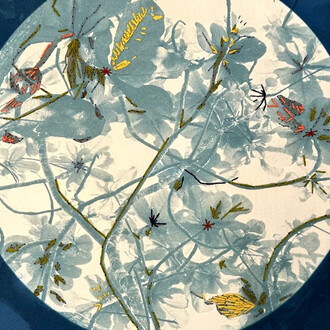I kinda like subtleties…
When you look at life, life is very seldom big events.
Dieterich Spahn (German, b. 1938, Cologne, Germany - d. November 2, 2021, Minneapolis, Minnesota) was a stained glass artist and painter. In a career that spanned more than five decades, his stained glass creations can be seen in over 200 places of worship, hospitals, universities, libraries and private residences throughout the United States. Some of his most notable works are located in Minnesota at the University of St. Thomas in St. Paul and at St. John’s Abbey in Collegeville. Though many may have come to know Spahn through his stained glass creations, he was also an innovative and prolific painter whose works hang in public and private collections worldwide.
Growing up in the austere landscape of post-war Germany, Spahn experienced firsthand the scarcity of childhood pleasures. Toys were a luxury beyond reach for most children of his generation. This absence, however, seems to have ignited a love and appreciation for these objects later in his life. Spahn began collecting antique toys from American culture, particularly popular western films, and he often enjoyed visiting toy shows and flea markets with his three sons.
These toys became a major source of imagery for Spahn’s paintings. In return for their inspiration, Spahn bestowed them with a fresh, new identity. He transformed the objects, painting them in contemporary colors on a large scale, resulting in images that are simple yet distinct, nostalgic yet modern.
It is not walk-by art. It is meditative art. You sit in front of it.
You keep looking at it, and every time you look at it,
you see something different. That’s the idea.
It’s not often the artist gives such clear instructions on how to view their art and having this insight deepens one’s appreciation for their work. The unorthodox materials and innovative techniques used in these paintings are quite specific to Spahn. Regardless of medium, each project began with a small sketch. For the Lone Ranger paintings, Spahn used a surprising material as the ground - steel wool. A protective layer of shellac was then applied. Spahn built the images in layers using commercial oil paints (yes, the kind you use on your cabinets, baseboards, etc.). He did not use a palette, but mixed the colors directly on the canvas.
The choice of materials and application method achieve a textural effect Spahn described as “…that of a tapestry” lending the paintings a “...subtle, soft quality”. An abstract background of repeating shapes and patterns lend a sense of life and movement. The combination of these elements alters how the painting looks depending on the time of day, direction of light and viewing angle, providing the viewer with an ever changing experience.
All these elements align with Spahn’s intent that his paintings ”…give the viewer visual enjoyment” and “…entice their observation to find objects that will only reveal themselves through further viewing.”
For Spahn, art was his calling, mission, purpose and life’s work. To honor his passion and devotion, contemplate the work as he intended. Deeply examine the changing details as objects begin to reveal themselves. Immerse yourself in the subtleties.











